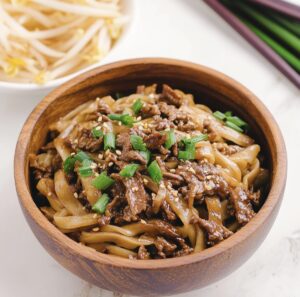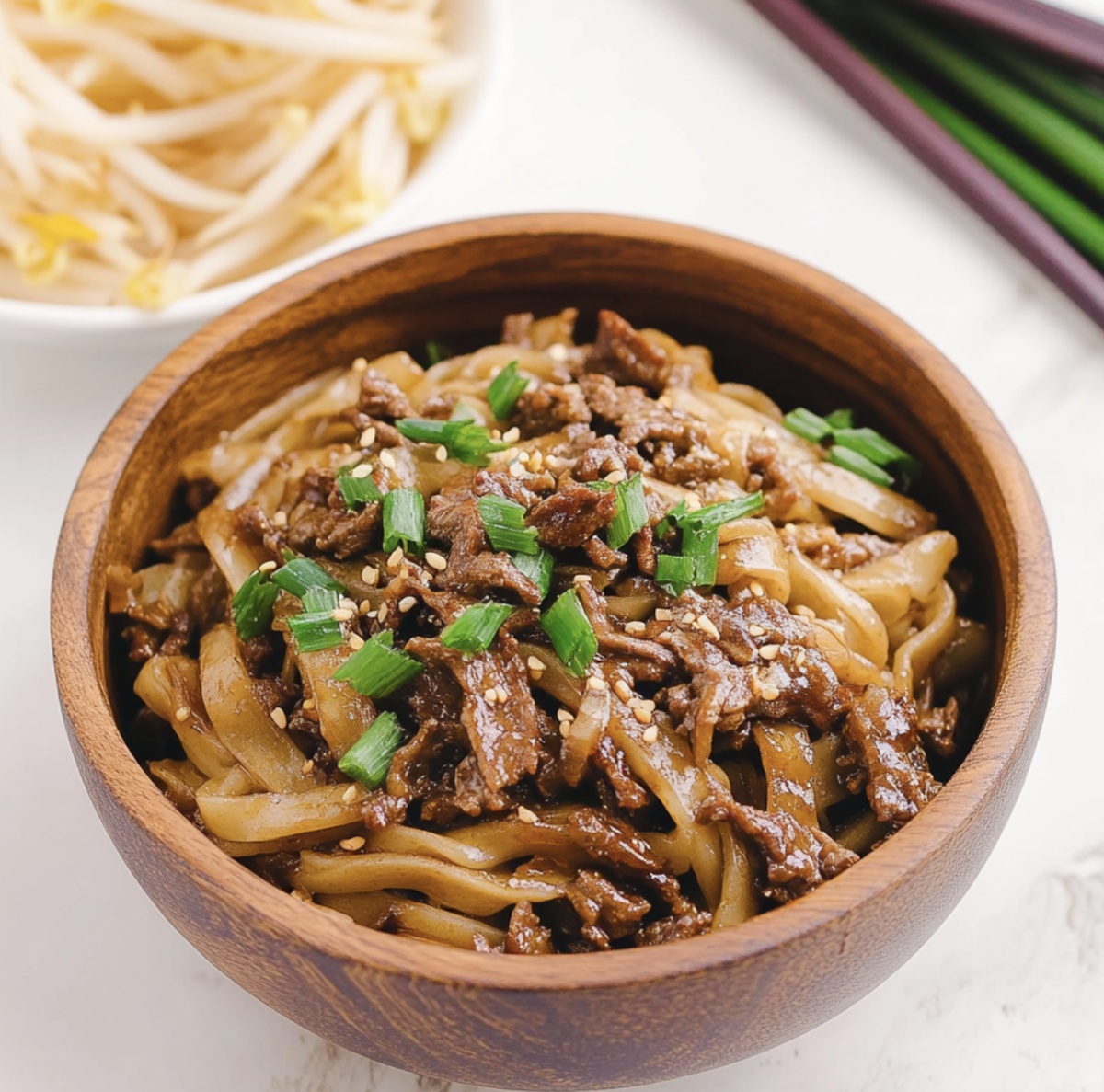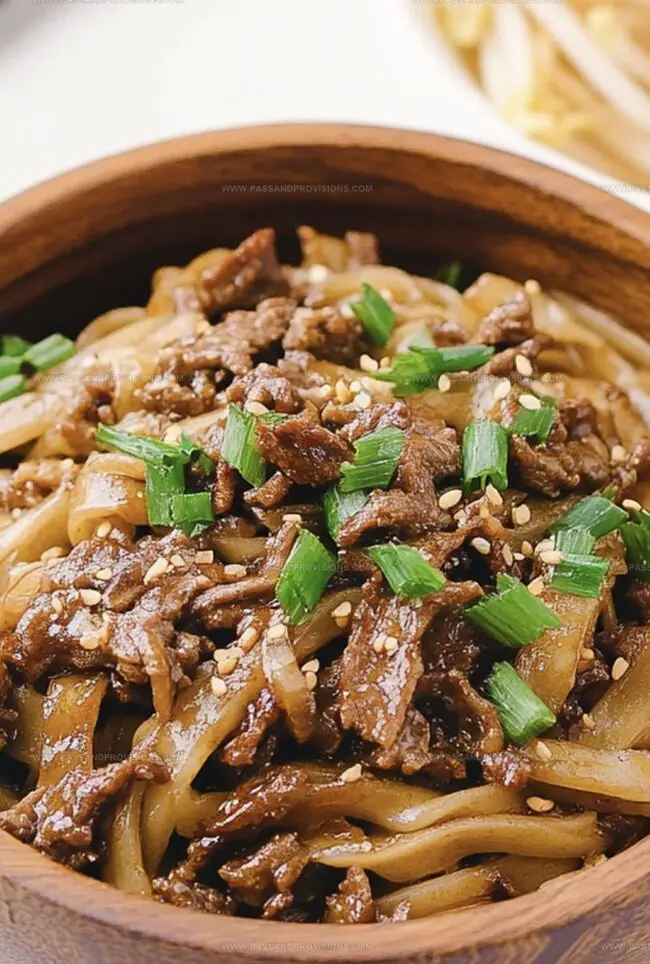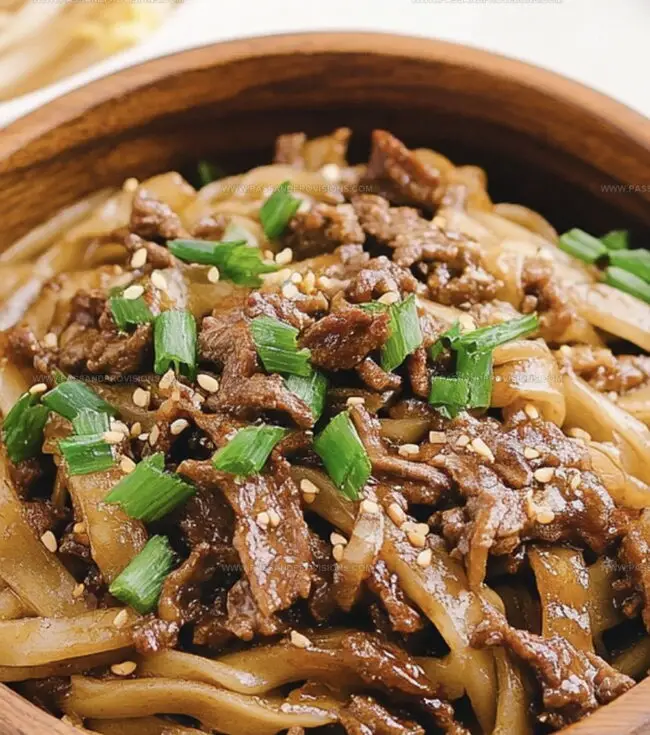Lip-Smacking Mongolian Beef and Noodle Recipe for Dinner Magic
Beef sizzles with an irresistible aroma in this mouthwatering Mongolian beef and noodle recipe that promises a flavor explosion.
Rich, tender strips of meat dance in a glossy, umami-packed sauce that tingles every taste bud.
The combination of soy sauce, garlic, and ginger creates a symphony of Asian-inspired flavors.
Noodles provide the perfect canvas for absorbing the delectable sauce, adding depth and texture to each bite.
Weeknight dinners transform into restaurant-quality experiences with this simple yet impressive dish.
Home cooks can easily master this recipe, bringing authentic Asian cuisine right to their kitchen.
Prepare to savor every single delicious forkful of this incredible meal.
Quick Recipe Overview
What Goes Into Mongolian Beef and Noodles
For Protein Base:For Flavor Enhancers:For Cooking Foundation:Tools You’ll Need for Mongolian Beef and Noodles
Step-by-Step for Mongolian Beef and Noodle Success
Slice the flank steak into delicate, thin strips. Generously coat each piece with cornstarch, ensuring an even, light dusting. Allow the meat to rest for a few minutes, letting the cornstarch create a protective layer.
Warm a large skillet or wok over high heat. Add a splash of oil and let it shimmer with anticipation. The pan should be sizzling hot before the beef touches its surface.
Carefully place the cornstarch-coated beef strips into the scorching pan. Cook quickly, turning the pieces to achieve a golden-brown crust on all sides. The goal is a crispy exterior with a tender interior.
In a separate bowl, whisk together soy sauce, brown sugar, garlic, and ginger. This magical mixture will transform your beef from good to absolutely mouthwatering.
Pour the sauce over the seared beef. Stir gently to coat every strip, allowing the flavors to meld and the sauce to slightly thicken. Let it simmer for a few moments, creating a glossy, irresistible coating.
While the beef is simmering, prepare your noodles according to package instructions. Aim for al dente perfection – tender but with a slight bite.
Toss the cooked noodles with the saucy beef. Sprinkle with green onions for a fresh, zesty finish. Serve immediately and watch everyone’s eyes light up with delight.
Pro Tweaks for Mongolian Beef and Noodle Flavor
Serving Suggestions for Mongolian Beef and Noodles
Storing Leftovers of Mongolian Beef and Noodles
Print
Savory Mongolian Beef And Noodle Recipe
- Total Time: 25 minutes
- Yield: 5 1x
Description
Savory Mongolian beef and noodle recipe delights with bold Asian flavors. Tender strips of beef mingle with silky noodles, creating a satisfying meal you’ll crave again and again.
Ingredients
- 1 lb flank steak or sirloin (thinly sliced against the grain)
- 8 oz (226 g) lo mein, udon, or spaghetti noodles (cooked according to package instructions)
- ⅓ cup (80 ml) low-sodium soy sauce
- ½ cup (120 ml) beef broth or water
- ¼ cup (50 g) brown sugar
- ¼ cup (30 g) cornstarch
- 2 tbsps (30 ml) vegetable oil
- 1 tbsp (15 ml) hoisin sauce
- 1 tbsp (15 ml) rice vinegar
- 1 tbsp (15 g) fresh ginger (minced)
- 3 cloves garlic (minced)
- ½ tsp red pepper flakes
- ½ cup (50 g) green onions (sliced)
- 1 tbsp sesame seeds
Instructions
- Prep Meat: Slice flank steak into thin, uniform strips to ensure even cooking and maximum flavor absorption.
- Cornstarch Coating: Thoroughly dust beef strips with cornstarch, creating a delicate protective layer that will produce a crispy, golden exterior when seared.
- Heat Preparation: Ignite wok or skillet to high temperature, generating an intense cooking surface for rapid caramelization and flavor sealing.
- Meat Searing: Execute quick stir-frying in small batches, developing rich golden-brown crusts on beef strips without overcrowding the cooking surface.
- Aromatic Foundation: Swiftly sauté minced garlic and ginger in the same pan, releasing robust flavors and creating a fragrant base for the sauce.
- Sauce Integration: Introduce sauce mixture, allowing it to simmer and transform into a glossy, rich coating that will envelop the beef and noodles.
- Flavor Fusion: Reunite seared beef with sauce, gently tossing to ensure comprehensive and even glaze coverage across each meat strip.
- Noodle Combination: Incorporate pre-cooked noodles into the wok, thoroughly mixing to create a harmonious blend of textures and deeply infused flavors.
- Final Flourish: Embellish with freshly chopped green onions and a sprinkle of sesame seeds, adding vibrant color and crisp textural contrast to the completed dish.
Notes
- Control Moisture When Coating: Pat beef strips completely dry before adding cornstarch to ensure maximum crispiness and prevent soggy texture.
- Manage High Heat Carefully: Use a well-seasoned wok or cast-iron skillet to handle intense heat without burning meat, maintaining optimal searing temperature.
- Batch Cooking Is Critical: Cook beef strips in small portions to prevent overcrowding, which leads to steaming instead of achieving golden-brown caramelization.
- Sauce Thickness Matters: Allow sauce to reduce and thicken naturally; if too thin, mix a small cornstarch slurry to achieve desired glossy consistency without diluting flavor.
- Prep Time: 10 minutes
- Cook Time: 15 minutes
- Category: Dinner, Lunch
- Method: Frying
- Cuisine: Mongolian
Nutrition
- Serving Size: 5
- Calories: 480
- Sugar: 10 g
- Sodium: 600 mg
- Fat: 20 g
- Saturated Fat: 3 g
- Unsaturated Fat: 14 g
- Trans Fat: 0 g
- Carbohydrates: 50 g
- Fiber: 2 g
- Protein: 25 g
- Cholesterol: 70 mg




William Hawkins
Founder & Culinary Director
Expertise
Education
Sullivan University, Louisville, KY
William Hawkins isn’t just a chef, he’s a storyteller through food. From his hometown of Louisville, KY, he’s spent years refining his craft, turning local ingredients into something extraordinary.
With classical training from Sullivan University and a career marked by innovation, mentorship, and Southern soul, William approaches every recipe with purpose. His kitchen is where old techniques meet fresh ideas, and where comfort food gets a thoughtful, modern twist.
When he’s not building dishes from the ground up, he’s out gathering inspiration from nature, markets, and the stories people share around the table.